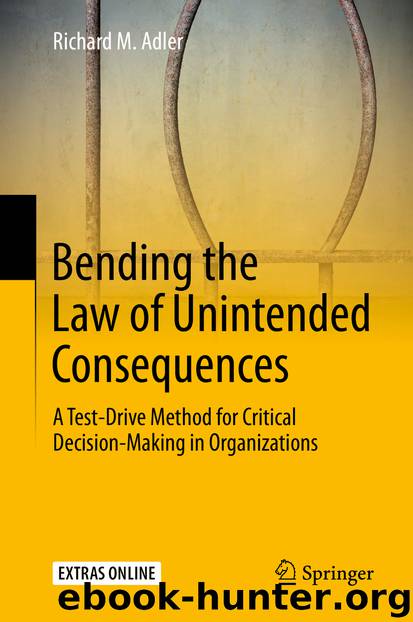Bending the Law of Unintended Consequences by Richard M. Adler

Author:Richard M. Adler
Language: eng
Format: epub
ISBN: 9783030327149
Publisher: Springer International Publishing
Tool-level developers are responsible for building, maintaining, and extending the simulation engine, data bases, and user interface supporting decision test drives—the test drive software infrastructure or platform. Solution-level software programmers collaborate with business experts and consultants to design and build test drive models tailored for particular types of critical decisions. Each such model specifies the ingredients for constructing dynamic scenarios to test drive one type of decision, such as competitive drug marketing strategy (cf. Chap. 10). Decision makers and analysts apply the test drive model that supports the critical decision type of interest. They design dynamic scenarios to model a decision they currently face, and gather the information needed to populate them. For example, analysts describe their company and other parties of interest and generate values for relevant attributes, relationships, and metrics. Most of this information would have to be collected in any case, even if a company opted to rely on “old school” approaches to decision-making. The extra information needed for test drives pertains to situational dynamics such as plans for decision options, events, trends, and forces. Decision makers and analysts are already aware of most of these dynamics from their business experience. However, conventional decision support tools such as predictive analytics or decision trees don’t provide the means to capture and leverage this behavioral knowledge. Once a test drive model is available, analysts create and populate dynamic scenarios using familiar graphical controls such as text boxes, tables, and sliders. They then run simulations and create familiar summary reports and graphic plots to analyze and compare scenario outcomes, without needing to know how the underlying simulation “sausage” is made.
How do test drives of dynamic simulations improve decision-making and bend LUC? Figure 9.5 depicts the answer. The inner dark gray box represents the company of interest, while the outer box depicts its environment, such as its market and perhaps a broader national or international economy. This environment contains numerous actors relating to a decision and various dynamic influences.16 The company’s current position or state is measured in terms of performance metrics specific to its market and type of decision. For simplicity, Fig. 9.5 displays only three metrics. Of course, most critical decisions require more metrics to assess outcomes.17 A dynamic scenario captures a company’s current performance as a baseline (black dot). Since critical decisions are complex, it is sensible to define the company’s goals as a range of attractive states rather than a precise point.18 Thus, the intended consequences of a decision are represented by a triangular region, which corresponds to Simon’s aspirational goals (cf. Sect. 5.3).
Fig. 9.5Simulation of a dynamic scenario
Download
This site does not store any files on its server. We only index and link to content provided by other sites. Please contact the content providers to delete copyright contents if any and email us, we'll remove relevant links or contents immediately.
Bad Blood by John Carreyrou(6581)
Rich Dad Poor Dad by Robert T. Kiyosaki(6506)
Principles: Life and Work by Ray Dalio(6296)
Playing to Win_ How Strategy Really Works by A.G. Lafley & Roger L. Martin(6076)
Management Strategies for the Cloud Revolution: How Cloud Computing Is Transforming Business and Why You Can't Afford to Be Left Behind by Charles Babcock(4546)
The Confidence Code by Katty Kay(4217)
Thinking in Bets by Annie Duke(4182)
American Kingpin by Nick Bilton(3812)
Delivering Happiness by Tony Hsieh(3394)
Project Animal Farm: An Accidental Journey into the Secret World of Farming and the Truth About Our Food by Sonia Faruqi(3189)
The Power of Habit by Charles Duhigg(3092)
The Tyranny of Metrics by Jerry Z. Muller(3025)
Brotopia by Emily Chang(3024)
The Marketing Plan Handbook: Develop Big-Picture Marketing Plans for Pennies on the Dollar by Robert W. Bly(3005)
Mastering Bitcoin: Programming the Open Blockchain by Andreas M. Antonopoulos(3005)
I Live in the Future & Here's How It Works by Nick Bilton(2958)
The Content Trap by Bharat Anand(2885)
Applied Empathy by Michael Ventura(2864)
Building a StoryBrand by Donald Miller(2862)
